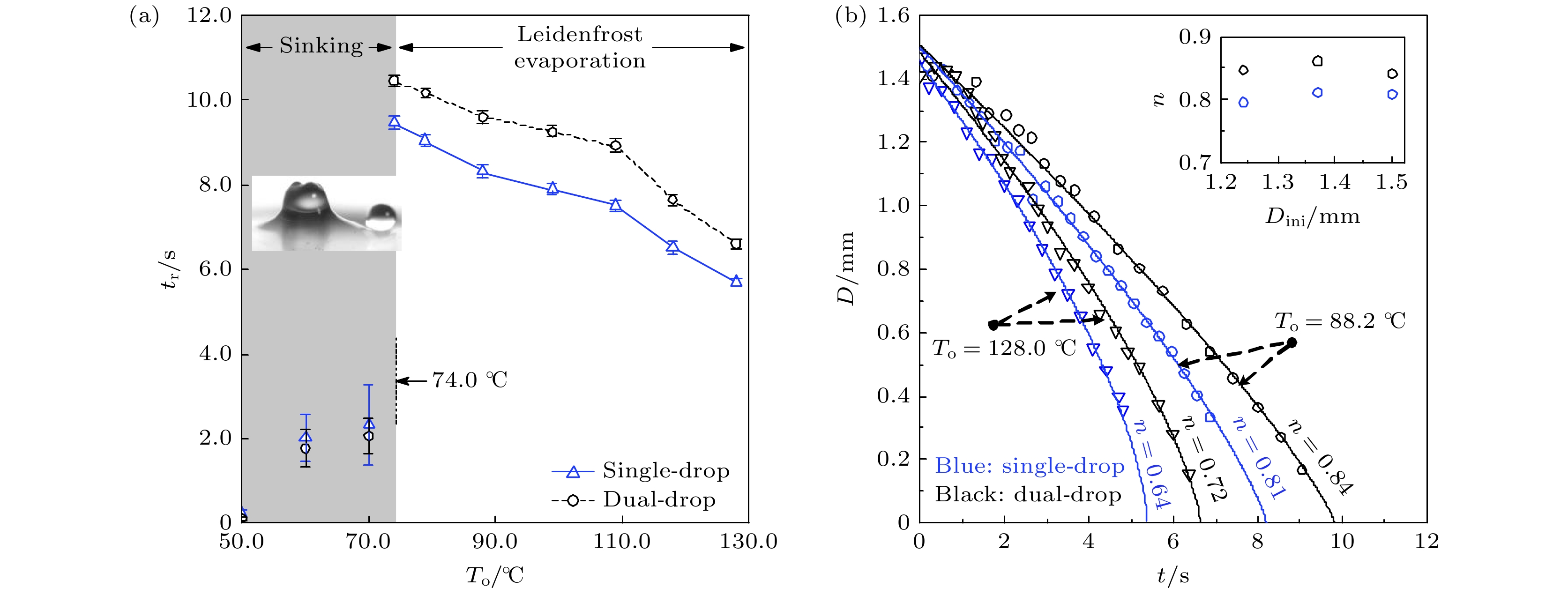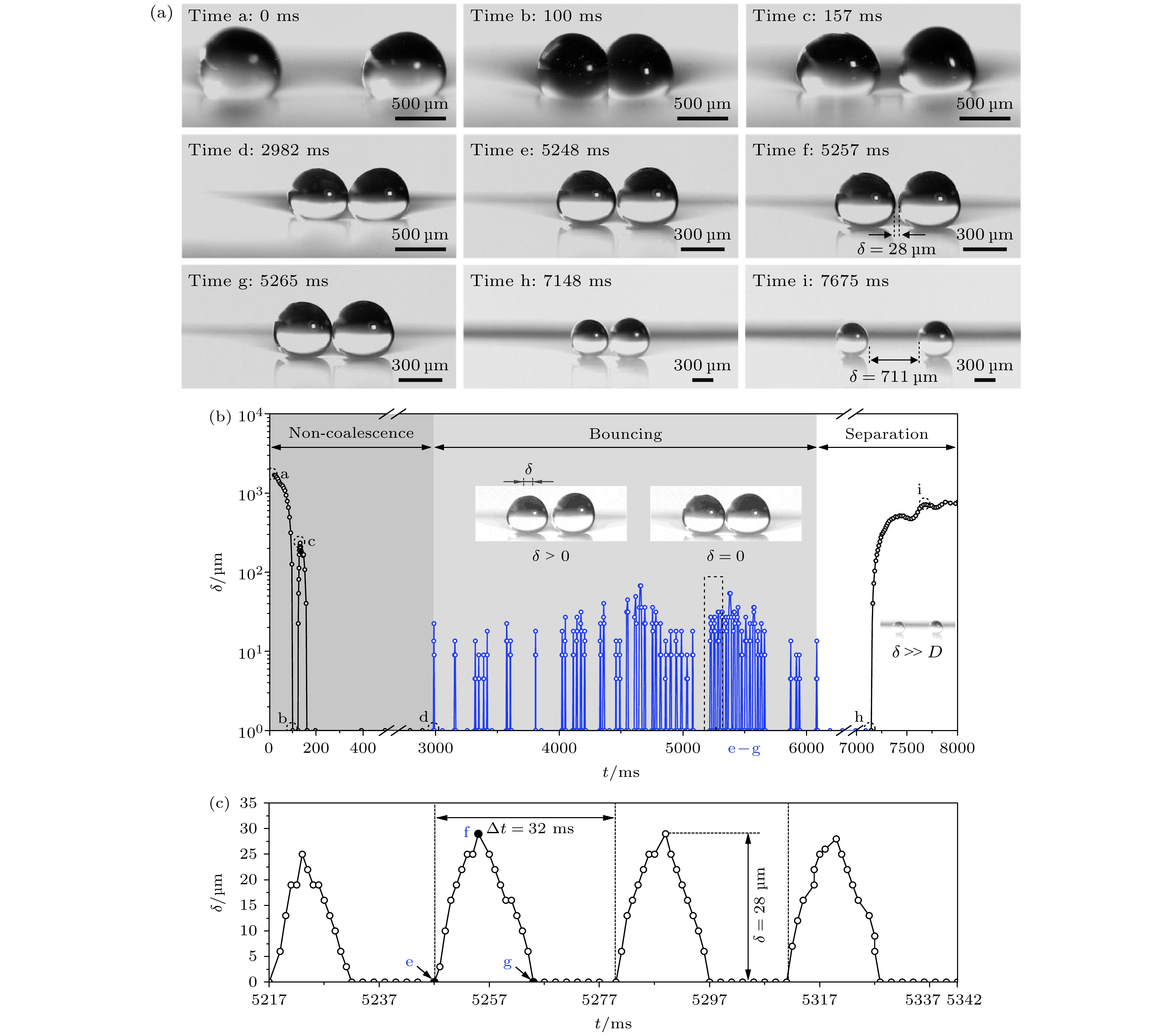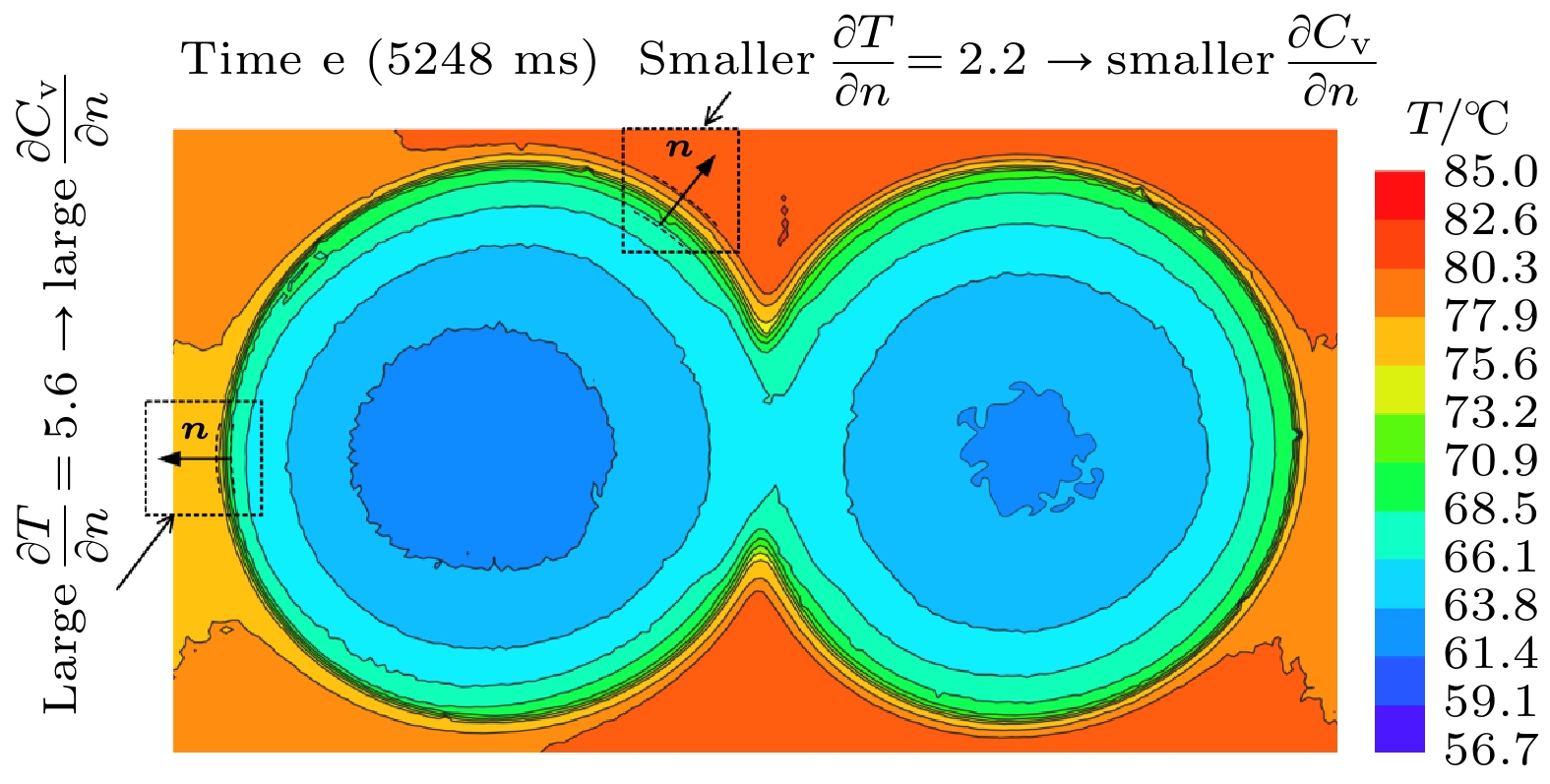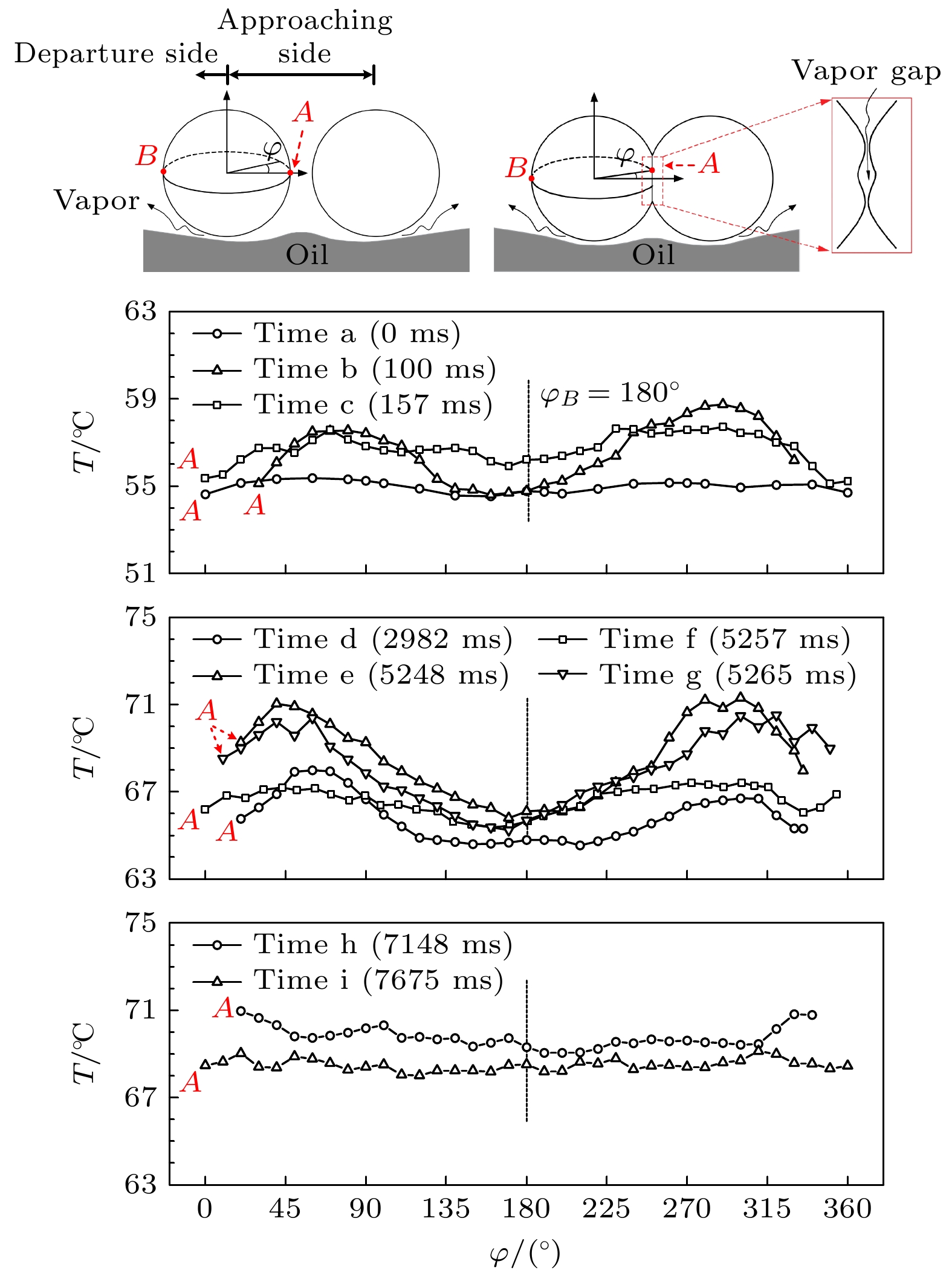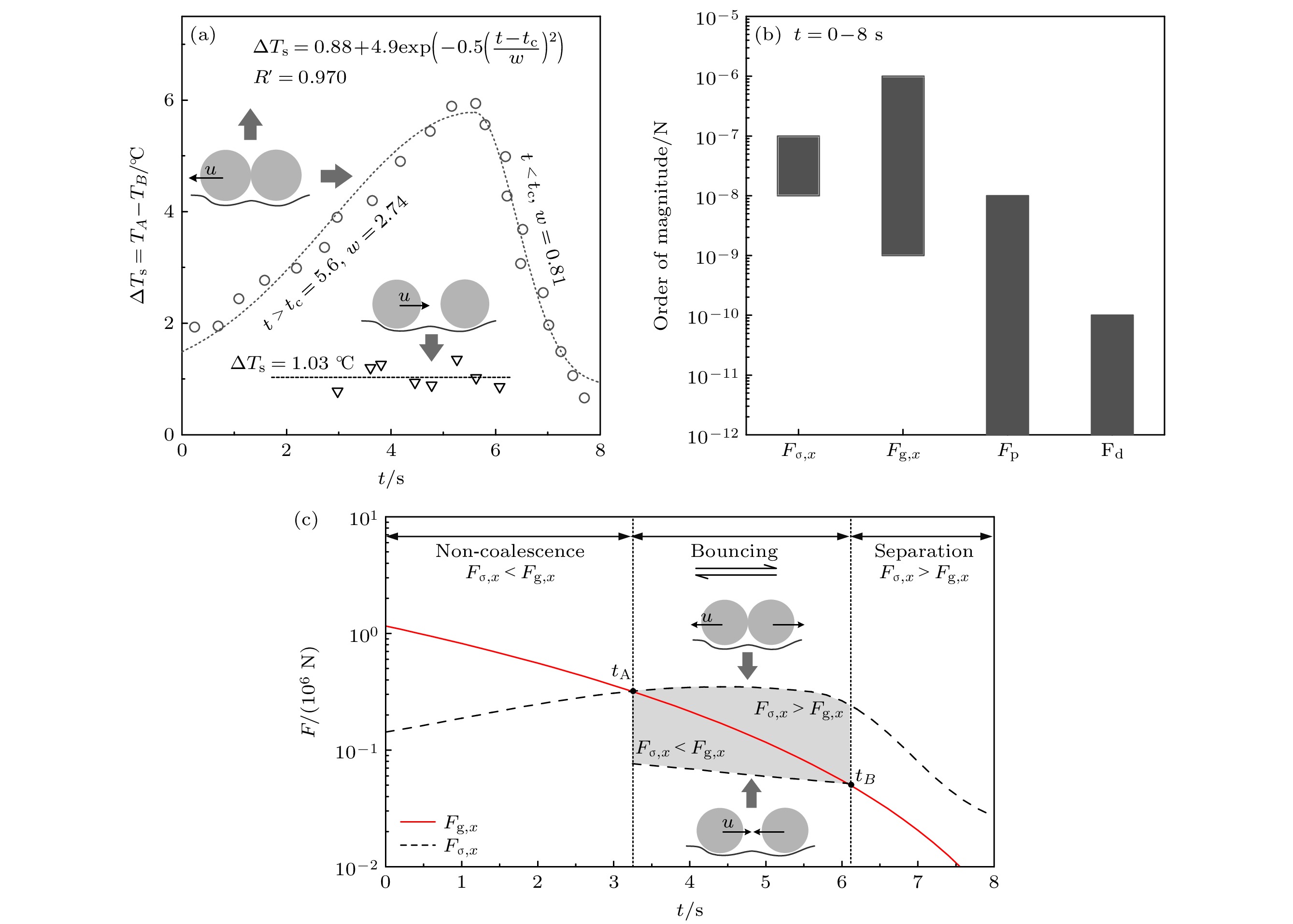-
热油面液滴蒸发是自然现象, 已有研究侧重于单滴蒸发, 对于热油面上多滴蒸发的认识较少. 本文研究了热硅油面两个等直径FC-72液滴的Leidenfrost蒸发, 油温为74.0—130.0 ℃, 液滴初始直径为1.5 mm, 采用红外热成像及高速摄影测量, 发现热油面液滴蒸发存在非聚合、弹跳、分离3个阶段. 本文理论分析了液滴在水平方向的受力, 包括非均匀液滴温度产生的Marangoni力、重力水平分量、润滑推动力、黏性力. 尺度分析表明Marangoni力和重力水平分量起关键作用, Marangoni力趋向于液滴分离, 重力水平分量趋向于液滴聚合. 在非聚合蒸发阶段, 重力水平分量克服Marangoni力, 但两液滴间存在气膜夹层, 解释了两个液滴看似接触但不聚合的现象. 随液滴尺寸减小, 重力水平分量减小, 不足以克服Marangoni力, 这是导致蒸发后期两滴分离的主要原因. 最后通过将模型得到的不同阶段间的转换时间同测量值进行对比, 证实了上述解释. 本文研究有助于理解复杂的Leidenfrost液滴动力学现象和机理.
-
关键词:
- Leidenfrost液滴 /
- 液滴动力学 /
- 蒸发 /
- 热量传递
Evaporation of droplets on a hot oil surface is a natural phenomenon. However, most of existing studies focus on the evaporation of a single droplet, and the evaporation of multiple droplets is insufficiently understood. Here, we explore the Leidenfrost evaporation of two identical FC-72 droplets on the surface of a hot oil bath. The oil temperature ranges from 73.6 to 126.6 ℃, and the evaporation of droplets each with an initial diameter of 1.5 mm is recorded by an infrared thermographer and a high-speed camera. The shallow oil depth keeps the oil temperature uniform relatively in the slot compared with that in the deep liquid pool due to the larger ratio of the surface area for copper-oil contact to the slot volume. We find that the neighboring droplets evaporate in three stages: non-coalescing, bouncing, and separating. The radius of neighboring Leidenfrost droplets follows the power law R(t)~(1−t/τ)n, where τ is the characteristic droplet lifetime and n is an exponent factor. Moreover, the diffusion-mediated interaction between the neighboring droplets slows down the evaporation process compared with the action of isolated Leidenfrost droplet and leads to an asymmetric temperature field on the droplet surface, thereby breaking the balance of the forces acting on the droplets. A simple dual-droplet evaporation model is developed which considers four forces acting horizontally on the droplet, namely, the Marangoni force resulting from the non-uniform droplet temperature, the gravity component, the lubrication-propulsion force, and the viscous drag force. Scale analysis shows that the Marangoni force and gravity component dominate dual-droplet evaporation dynamics. In the non-coalescence stage, the gravity component induces the droplets to attract each other, while the vapor film trapped between droplets prevents them from directly contacting. When the droplets turn smaller, the gravity component is insufficient to overcome the Marangoni force. Hence, the droplets separate in the final evaporation stage. Finally, we conclude that the competition between Marangoni force and gravitational force is the origin of the bounce evaporation by comparing the theoretical and experimental transition times at distinct stages. This study contributes to explaining the complex Leidenfrost droplet dynamics and evaporation mechanism.-
Keywords:
- Leidenfrost droplets /
- droplet dynamics /
- evaporation /
- heat transfer
[1] Biance A L, Clanet C, Quééréé D 2003 Phys. Fluids 15 1632
 Google Scholar
Google Scholar
[2] Tran T, Staat H J, Prosperetti A, Sun C, Lohse D 2012 Phys. Rev. Lett. 108 036101
 Google Scholar
Google Scholar
[3] Davanlou A, Kumar R 2015 Sci. Rep. 5 9531
 Google Scholar
Google Scholar
[4] Luo C, Mrinal M, Wang X 2017 Sci. Rep. 7 12018
 Google Scholar
Google Scholar
[5] Abdelaziz R, Disci-Zayed D, Hedayati M K, Pohls J H, Zillohu A U, Erkartal B, Chakravadhanula V S, Duppel V, Kienle L, Elbahri M 2013 Nat. Commun. 4 2400
 Google Scholar
Google Scholar
[6] Schwenzer B 2014 MRS Bull. 39 7
 Google Scholar
Google Scholar
[7] Kleinstreuer C, Zhang Z 2010 Annu. Rev. Fluid Mech. 42 301
 Google Scholar
Google Scholar
[8] Bouillant A, Mouterde T, Bourrianne P, Lagarde A, Clanet C, Quéré D 2018 Nat. Phys. 14 1188
 Google Scholar
Google Scholar
[9] Graeber G, Regulagadda K, Hodel P, Kuttel C, Landolf D, Schutzius T M, Poulikakos D 2021 Nat. Commun. 12 1727
 Google Scholar
Google Scholar
[10] Brunet P, Snoeijer J H 2011 Eur. Phys. J. Spec. Top. 192 207
 Google Scholar
Google Scholar
[11] Linke H, Aleman B J, Melling L D, Taormina M J, Francis M J, Dow-Hygelund C C, Narayanan V, Taylor R P, Stout A 2006 Phys. Rev. Lett. 96 154502
 Google Scholar
Google Scholar
[12] Bouillant A, Lafoux B, Clanet C, Quere D 2021 Soft Matter 17 8805
 Google Scholar
Google Scholar
[13] van Limbeek M A J, Sobac B, Rednikov A, Colinet P, Snoeijer J H 2019 J. Fluid Mech. 863 1157
 Google Scholar
Google Scholar
[14] Gauthier A, Diddens C, Proville R, Lohse D, van der Meer D 2019 Proc. Natl. Acad. Sci. USA 116 1174
 Google Scholar
Google Scholar
[15] Matsumoto R, Hasegawa K 2021 Sci. Rep. 11 3954
 Google Scholar
Google Scholar
[16] Gauthier A, Lajoinie G, Snoeijer J H, van der Meer D 2020 Soft Matter 16 4043
 Google Scholar
Google Scholar
[17] Maquet L, Sobac B, Darbois-Texier B, Duchesne A, Brandenbourger M, Rednikov A, Colinet P, Dorbolo S 2016 Phys. Rev. Fluids 1 053902
[18] Pacheco-Vazquez F, Ledesma-Alonso R, Palacio-Rangel J L, Moreau F 2021 Phys. Rev. Lett. 127 204501
 Google Scholar
Google Scholar
[19] Carrier O, Shahidzadeh-Bonn N, Zargar R, Aytouna M, Habibi M, Eggers J, Bonn D 2016 J. Fluid Mech. 798 774
 Google Scholar
Google Scholar
[20] Schäfle C, Bechinger C, Rinn B, David C, Leiderer P 1999 Phys. Rev. Lett. 83 5302
 Google Scholar
Google Scholar
[21] Kobayashi M, Makino M, Okuzono T, Doi M 2010 J. Phys. Soc. Jpn. 79 044802
[22] Couder Y, Protiere S, Fort E, Boudaoud A 2005 Nature 437 208
 Google Scholar
Google Scholar
[23] Harris D M, Bush J W M 2014 J. Fluid Mech. 739 444
 Google Scholar
Google Scholar
[24] Bozzano G, Dente M 2013 Icheap-11:11 th International Conference on Chemical and Process Engineering, Pts 1-4 32 1489
 Google Scholar
Google Scholar
[25] Valani R N, Slim A C, Simula T 2019 Phys. Rev. Lett. 123 024503
 Google Scholar
Google Scholar
[26] Yan X, Xu J, Meng Z, Xie J, Liu G 2020 Langmuir 36 1680
 Google Scholar
Google Scholar
[27] Xu J L, Yan X, Liu G H, Xie J 2019 Nano Energy 57 791
 Google Scholar
Google Scholar
[28] Zawala J, Dorbolo S, Terwagne D, Vandewalle N, Malysa K 2011 Soft Matter 7 6719
 Google Scholar
Google Scholar
[29] Khilifi D, Foudhil W, Fahem K, Harmand S, Ben Jabrallah S 2019 Therm. Sci. 23 1105
 Google Scholar
Google Scholar
[30] Wang H, Xu J, Ma X, Xie J 2022 Phys. Fluids 34 093320
[31] Inamuro T, Tajima S, Ogino F 2004 Int. J. Heat Mass Transfer 47 4649
 Google Scholar
Google Scholar
[32] Leong F Y, Le D V 2020 Phys. Fluids 32 062102
[33] Annamalai K, Ryan W 1992 Prog. Energy Combust. Sci. 18 221
 Google Scholar
Google Scholar
[34] Zheng S F, Eimann F, Philipp C, Fieback T, Gross U 2019 Int. J. Heat Mass Transfer 141 34
 Google Scholar
Google Scholar
[35] Annamalai K, Ryan W, Chandra S 1993 J. Heat Transfer 115 707
 Google Scholar
Google Scholar
[36] Sokuler M, Auernhammer G K, Liu C J, Bonaccurso E, Butt H J 2010 Epl. Europhys. Lett. 89 36004
 Google Scholar
Google Scholar
[37] Pradhan T K, Panigrahi P K 2016 Colloid Surface A 500 154
 Google Scholar
Google Scholar
[38] Larson R G 2014 AlChE J. 60 1538
 Google Scholar
Google Scholar
[39] Fairhurst D J 2022 J. Fluid Mech. 934 F1
[40] Wray A W, Wray P S, Duffy B R, Wilson S K 2021 Phys. Rev. Fluids 6 073604
[41] Wray A W, Duffy B R, Wilson S K 2020 J. Fluid Mech. 884 A45
[42] Bergman T L, Bergman T L, Incropera F P, Dewitt D P, Lavine A S 2011 Fundamentals of Heat and Mass Transfer (John Wiley & Sons)
[43] Yu X, Xu J 2020 Appl. Phys. Lett. 116 253903
[44] Ding Y J, Liu J 2016 Appl. Phys. Lett. 109 121904
[45] Yan X, Xu J, Meng Z, Xie J, Wang H 2020 Small 16 e2001548
 Google Scholar
Google Scholar
[46] Janssens S D, Koizumi S, Fried E 2017 Phys. Fluids 29 032103
-
图 1 (a) 实验装置图; (b), (c)放大的带有薄液池的加热铜块(1-高速摄像机, 2-红外高速相机, 3-微量注射器, 4-位移调节平台, 5-电源变压器, 6-PID温度控制器, 7-带薄液池的铜块, 8-光源, 9-用于释放液滴的冷却针头)
Fig. 1. Photograph of experimental setup (a) and enlarged copper block with thin liquid pool (b), (c) (1-high speed camera, 2-infrared radiation image camera, 3-micro-syringe pump, 4-displacement adjustment platform, 5-voltage transformer, 6-PID temperature controller, 7- copper block with thin liquid pool, 8-light source, 9-cooled dual-needles for droplet release).
图 7 油面双滴非聚合蒸发的力学分析 (a) 施加在倾斜液滴上的各种力; (b) 润滑推动力; (c) Leidenfrost蒸气层与空气交界处的Marangoni力; (d) 气膜出口位置的液滴表面张力圆周分布; (e) 沿x方向分布的液滴表面温度; (f) 作用在倾斜油面上的液滴重力; (g) 油面倾斜角α 与液滴邦德数Bo之间的关系
Fig. 7. Force analysis explaining the non-coalescence phenomenon of dual-droplets over oil surface: (a) Various forces exerted on inclined droplets; (b) lubrication-propulsion force; (c) Marangoni force along circumference direction at the junction between Leidenfrost vapor layer and air; (d) distribution of droplet surface tension along the x-direction at the vapor outlet; (e) distribution of droplet surface temperature along the x-direction; (f) droplet gravity on the inclined oil surface; (g) the relationship between the oil surface’s inclination angle α and the droplet’s bond number.
图 8 液滴温度和各种力的变化 (a) 测量的液滴温度与时间的关系, 以及用简单的拟合得到的两条曲线; (b) 各种力大小的比较; (c) 竞争的重力Fg, x和Marangoni力Fσ, x主导了液滴动力学的三态行为
Fig. 8. Variation of droplet temperatures and various forces: (a) The measured droplet temperature versus time and two curve obtained with simple fitting; (b) comparison of various forces magnitudes; (c) competing gravity force Fg, x and Marangoni force Fσ, x dominate the three-regimes behavior of droplet dynamics.
表 1 在1 atm (1 atm = 1.013×105 Pa) 的压力下, FC-72和硅油的物性参数
Table 1. Physical properties of FC-72 and silicon oil at 1 atm (1 atm = 1.013×105 Pa).
参数 值 FC-72
(液体)饱和温度 (1 atm) Tsat/℃ 56.6 密度 ρd/( kg·m–3) 1680 比热容 cpl/(J·m–1·K–1) 1100 潜热 L/(kJ·kg–1) 88 导热率 λd(W·m–1·K–1) 0.057 动力黏度 μd/(kg·m–1·s–1) 0.64×10–3 FC-72
(蒸气)密度 ρv/(kg·m–3) 9.7 比热容 cpv/(J·m–1·K–1) 900 热导率 λv/(W·m–1·K–1) 0.0235 动力黏度 μv/(kg·m–1·s–1) 1.31×10–6 硅油 密度 ρo/(kg·m–3) 960 比热容 cpo/(J·m–1·K–1) 1460 动力黏度 μo/(kg·m–1·s–1) 0.048 表面张力(25 ℃) σo/(N·m–1) 0.0208 -
[1] Biance A L, Clanet C, Quééréé D 2003 Phys. Fluids 15 1632
 Google Scholar
Google Scholar
[2] Tran T, Staat H J, Prosperetti A, Sun C, Lohse D 2012 Phys. Rev. Lett. 108 036101
 Google Scholar
Google Scholar
[3] Davanlou A, Kumar R 2015 Sci. Rep. 5 9531
 Google Scholar
Google Scholar
[4] Luo C, Mrinal M, Wang X 2017 Sci. Rep. 7 12018
 Google Scholar
Google Scholar
[5] Abdelaziz R, Disci-Zayed D, Hedayati M K, Pohls J H, Zillohu A U, Erkartal B, Chakravadhanula V S, Duppel V, Kienle L, Elbahri M 2013 Nat. Commun. 4 2400
 Google Scholar
Google Scholar
[6] Schwenzer B 2014 MRS Bull. 39 7
 Google Scholar
Google Scholar
[7] Kleinstreuer C, Zhang Z 2010 Annu. Rev. Fluid Mech. 42 301
 Google Scholar
Google Scholar
[8] Bouillant A, Mouterde T, Bourrianne P, Lagarde A, Clanet C, Quéré D 2018 Nat. Phys. 14 1188
 Google Scholar
Google Scholar
[9] Graeber G, Regulagadda K, Hodel P, Kuttel C, Landolf D, Schutzius T M, Poulikakos D 2021 Nat. Commun. 12 1727
 Google Scholar
Google Scholar
[10] Brunet P, Snoeijer J H 2011 Eur. Phys. J. Spec. Top. 192 207
 Google Scholar
Google Scholar
[11] Linke H, Aleman B J, Melling L D, Taormina M J, Francis M J, Dow-Hygelund C C, Narayanan V, Taylor R P, Stout A 2006 Phys. Rev. Lett. 96 154502
 Google Scholar
Google Scholar
[12] Bouillant A, Lafoux B, Clanet C, Quere D 2021 Soft Matter 17 8805
 Google Scholar
Google Scholar
[13] van Limbeek M A J, Sobac B, Rednikov A, Colinet P, Snoeijer J H 2019 J. Fluid Mech. 863 1157
 Google Scholar
Google Scholar
[14] Gauthier A, Diddens C, Proville R, Lohse D, van der Meer D 2019 Proc. Natl. Acad. Sci. USA 116 1174
 Google Scholar
Google Scholar
[15] Matsumoto R, Hasegawa K 2021 Sci. Rep. 11 3954
 Google Scholar
Google Scholar
[16] Gauthier A, Lajoinie G, Snoeijer J H, van der Meer D 2020 Soft Matter 16 4043
 Google Scholar
Google Scholar
[17] Maquet L, Sobac B, Darbois-Texier B, Duchesne A, Brandenbourger M, Rednikov A, Colinet P, Dorbolo S 2016 Phys. Rev. Fluids 1 053902
[18] Pacheco-Vazquez F, Ledesma-Alonso R, Palacio-Rangel J L, Moreau F 2021 Phys. Rev. Lett. 127 204501
 Google Scholar
Google Scholar
[19] Carrier O, Shahidzadeh-Bonn N, Zargar R, Aytouna M, Habibi M, Eggers J, Bonn D 2016 J. Fluid Mech. 798 774
 Google Scholar
Google Scholar
[20] Schäfle C, Bechinger C, Rinn B, David C, Leiderer P 1999 Phys. Rev. Lett. 83 5302
 Google Scholar
Google Scholar
[21] Kobayashi M, Makino M, Okuzono T, Doi M 2010 J. Phys. Soc. Jpn. 79 044802
[22] Couder Y, Protiere S, Fort E, Boudaoud A 2005 Nature 437 208
 Google Scholar
Google Scholar
[23] Harris D M, Bush J W M 2014 J. Fluid Mech. 739 444
 Google Scholar
Google Scholar
[24] Bozzano G, Dente M 2013 Icheap-11:11 th International Conference on Chemical and Process Engineering, Pts 1-4 32 1489
 Google Scholar
Google Scholar
[25] Valani R N, Slim A C, Simula T 2019 Phys. Rev. Lett. 123 024503
 Google Scholar
Google Scholar
[26] Yan X, Xu J, Meng Z, Xie J, Liu G 2020 Langmuir 36 1680
 Google Scholar
Google Scholar
[27] Xu J L, Yan X, Liu G H, Xie J 2019 Nano Energy 57 791
 Google Scholar
Google Scholar
[28] Zawala J, Dorbolo S, Terwagne D, Vandewalle N, Malysa K 2011 Soft Matter 7 6719
 Google Scholar
Google Scholar
[29] Khilifi D, Foudhil W, Fahem K, Harmand S, Ben Jabrallah S 2019 Therm. Sci. 23 1105
 Google Scholar
Google Scholar
[30] Wang H, Xu J, Ma X, Xie J 2022 Phys. Fluids 34 093320
[31] Inamuro T, Tajima S, Ogino F 2004 Int. J. Heat Mass Transfer 47 4649
 Google Scholar
Google Scholar
[32] Leong F Y, Le D V 2020 Phys. Fluids 32 062102
[33] Annamalai K, Ryan W 1992 Prog. Energy Combust. Sci. 18 221
 Google Scholar
Google Scholar
[34] Zheng S F, Eimann F, Philipp C, Fieback T, Gross U 2019 Int. J. Heat Mass Transfer 141 34
 Google Scholar
Google Scholar
[35] Annamalai K, Ryan W, Chandra S 1993 J. Heat Transfer 115 707
 Google Scholar
Google Scholar
[36] Sokuler M, Auernhammer G K, Liu C J, Bonaccurso E, Butt H J 2010 Epl. Europhys. Lett. 89 36004
 Google Scholar
Google Scholar
[37] Pradhan T K, Panigrahi P K 2016 Colloid Surface A 500 154
 Google Scholar
Google Scholar
[38] Larson R G 2014 AlChE J. 60 1538
 Google Scholar
Google Scholar
[39] Fairhurst D J 2022 J. Fluid Mech. 934 F1
[40] Wray A W, Wray P S, Duffy B R, Wilson S K 2021 Phys. Rev. Fluids 6 073604
[41] Wray A W, Duffy B R, Wilson S K 2020 J. Fluid Mech. 884 A45
[42] Bergman T L, Bergman T L, Incropera F P, Dewitt D P, Lavine A S 2011 Fundamentals of Heat and Mass Transfer (John Wiley & Sons)
[43] Yu X, Xu J 2020 Appl. Phys. Lett. 116 253903
[44] Ding Y J, Liu J 2016 Appl. Phys. Lett. 109 121904
[45] Yan X, Xu J, Meng Z, Xie J, Wang H 2020 Small 16 e2001548
 Google Scholar
Google Scholar
[46] Janssens S D, Koizumi S, Fried E 2017 Phys. Fluids 29 032103
计量
- 文章访问数: 7117
- PDF下载量: 97
- 被引次数: 0













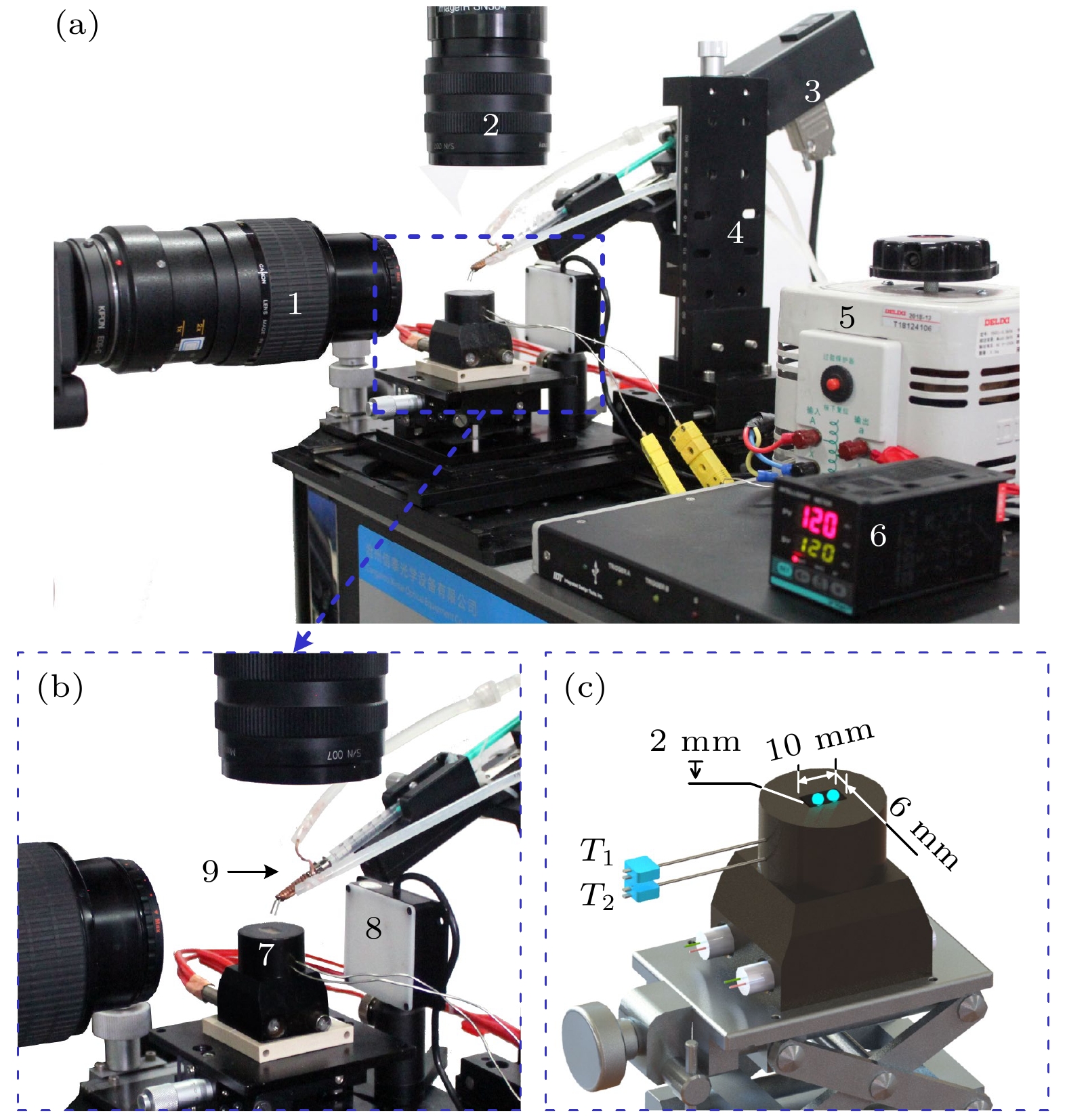
 下载:
下载:

